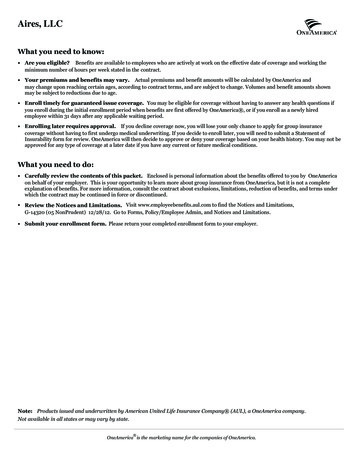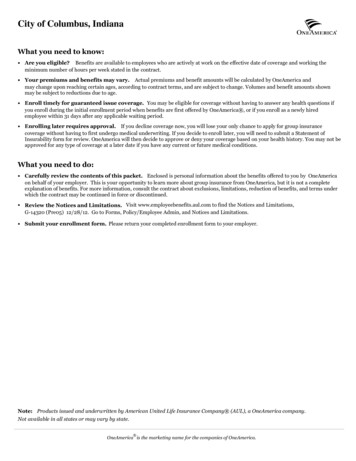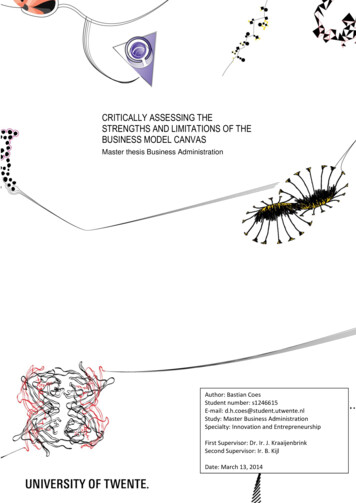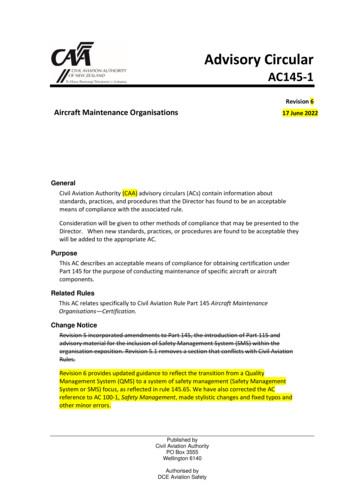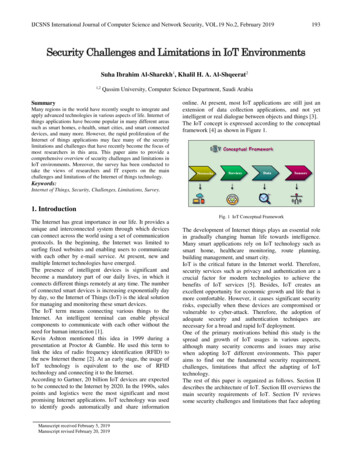
Transcription
IJCSNS International Journal of Computer Science and Network Security, VOL.19 No.2, February 2019193Security Challenges and Limitations in IoT EnvironmentsSuha Ibrahim Al-Sharekh1, Khalil H. A. Al-Shqeerat21,2Qassim University, Computer Science Department, Saudi ArabiaSummaryMany regions in the world have recently sought to integrate andapply advanced technologies in various aspects of life. Internet ofthings applications have become popular in many different areassuch as smart homes, e-health, smart cities, and smart connecteddevices, and many more. However, the rapid proliferation of theInternet of things applications may face many of the securitylimitations and challenges that have recently become the focus ofmost researchers in this area. This paper aims to provide acomprehensive overview of security challenges and limitations inIoT environments. Moreover, the survey has been conducted totake the views of researchers and IT experts on the mainchallenges and limitations of the Internet of things technology.online. At present, most IoT applications are still just anextension of data collection applications, and not yetintelligent or real dialogue between objects and things [3].The IoT concept is expressed according to the conceptualframework [4] as shown in Figure 1.Keywords:Internet of Things, Security, Challenges, Limitations, Survey.1. IntroductionFig. 1 IoT Conceptual FrameworkThe Internet has great importance in our life. It provides aunique and interconnected system through which devicescan connect across the world using a set of communicationprotocols. In the beginning, the Internet was limited tosurfing fixed websites and enabling users to communicatewith each other by e-mail service. At present, new andmultiple Internet technologies have emerged.The presence of intelligent devices is significant andbecome a mandatory part of our daily lives, in which itconnects different things remotely at any time. The numberof connected smart devices is increasing exponentially dayby day, so the Internet of Things (IoT) is the ideal solutionfor managing and monitoring these smart devices.The IoT term means connecting various things to theInternet. An intelligent terminal can enable physicalcomponents to communicate with each other without theneed for human interaction [1].Kevin Ashton mentioned this idea in 1999 during apresentation at Proctor & Gamble. He used this term tolink the idea of radio frequency identification (RFID) tothe new Internet theme [2]. At an early stage, the usage ofIoT technology is equivalent to the use of RFIDtechnology and connecting it to the Internet.According to Gartner, 20 billion IoT devices are expectedto be connected to the Internet by 2020. In the 1990s, salespoints and logistics were the most significant and mostpromising Internet applications. IoT technology was usedto identify goods automatically and share informationManuscript received February 5, 2019Manuscript revised February 20, 2019The development of Internet things plays an essential rolein gradually changing human life towards intelligence.Many smart applications rely on IoT technology such assmart home, healthcare monitoring, route planning,building management, and smart city.IoT is the critical future in the Internet world. Therefore,security services such as privacy and authentication are acrucial factor for modern technologies to achieve thebenefits of IoT services [5]. Besides, IoT creates anexcellent opportunity for economic growth and life that ismore comfortable. However, it causes significant securityrisks, especially when these devices are compromised orvulnerable to cyber-attack. Therefore, the adoption ofadequate security and authentication techniques arenecessary for a broad and rapid IoT deployment.One of the primary motivations behind this study is thespread and growth of IoT usages in various aspects,although many security concerns and issues may arisewhen adopting IoT different environments. This paperaims to find out the fundamental security requirement,challenges, limitations that affect the adapting of IoTtechnology.The rest of this paper is organized as follows. Section IIdescribes the architecture of IoT. Section III overviews themain security requirements of IoT. Section IV reviewssome security challenges and limitations that face adopting
194IJCSNS International Journal of Computer Science and Network Security, VOL.19 No.2, February 2019IoT technology. Finally, the results of the conductedsurvey are discussed in section V.2. IoT ArchitectureIoT was introduced as a third wave of web pages afterstatic web pages (WWW). A global network connectsdifferent types of objects from anywhere, and anytimeusing Internet protocol (IP) [6].According to [7, 8], the IoT architecture consists of fivelayers; perception, network, middleware, application, andbusiness Layers, as shown in Figure 2.based on communication techniques used such as Wi-Fi,and Bluetooth [11].3) Middleware LayerMiddleware Layer is also known as a processing layer. Itis built over the network layer. In this layer, the IoTsystems run [12]. It provides an API (ApplicationProgramming Interface) to implement applications.Moreover, it provides many services such as data analysis,data processing, detect and manage devices, data collection,and discovery of information by Object Naming Service(ONS) or Electronic Product Code (EPC). MiddlewareLayer uses standard protocols that as CoAP, MQTT,XMPP, and HTTP.4) Application LayerThe application layer contains an application user interface.Applications that are part of the application layer consumeweb services and application-programming interface that isexposed to the middle layer. It is responsible for deliveryand providing various applications in many areas whereIoT technology can be deployed and applied, for example,smart homes, smart cities, smart health, and others [13].The primary goal of the Application layer is to connect IoTusers and applications.Fig. 2 IoT Architecture Layers1) Perception LayerThe perception layer is also called the recognition layer.The essential task of this layer is to identify the objects andcollect information. This layer consists of a group ofphysical objects, things. It is responsible for collecting dataand providing information to the objects. Theresponsibility of the layer is to secure how data is collected,stored and transmitted to the network layer. The perceptionlayer includes RFID (Radio-Frequency Identification),sensors, camera, GPS (The Global Positioning System),etc. and it depends on the characteristics of each element,such as protocols or communication technologies used [9].2) Network layerThe most advanced layer of conventional IoT architectureis the network layer. It likes a neural network andconsiders the brain of IoT. The network layer isresponsible for transferring and processing data providedby the perception layer. It has a significant role in handlingthe data related to IoT management [10].The network and communication technology used in thislayer such as wired, wireless and satellite depend on thetechniques adopted by the perception layer [9]. Theperception layer is closely related to the network layer5) Business LayerThe business layer manages the whole IoT systems such asapplications, business models, and data have been receivedfrom the application layer. The business layer developsIoT applications and contributes to the development ofsuccessful business models for the promotion of IoTrelated technologies [14]. Furthermore, this layer shouldmanage and maintain the privacy of users, which isindispensable to the internet of things.3. Security RequirementsFundamental security issues in IoT systems requireprotecting two critical aspects, which are confidential dataand identity authentication. Furthermore, five mainrequirements in information security are considered; dataavailability, data confidentiality, data integrity, authenticity,and authorization and breach any of these areas will causesecurity damages or problems to the IoT system [15].Correspondingly, each of the five layers of IoT must meetthese requirements. Figure 3 shows the main securityrequirements for IoT environment.a) Data AvailabilityData availability is crucial in the IoT. It contributes toensuring that users have access to the security andreliability of available data. IoT system needs to providebackup of vital information to prevent data loss. Someattacks cause harms related to data availability such as
IJCSNS International Journal of Computer Science and Network Security, VOL.19 No.2, February 2019denial-of-service (DoS) and distributed-denial of services(DDoS) attacks [15].195this section, we will explain some of these potentialsecurity challenges in the IoT environment.1. Lack of skills:Specific skills and expertise are essential factors requiredfor designing, implementing, developing, and managingsecurity that must be considered. The disruption of any ofthese factors may cause damage to the security system inIoT. Furthermore, lack of skills and expertise cause slowadoption of IoT technologies [18, 19].The number of skilled people who can adequately handleIoT techniques is very limited. Getting the benefits of IoTtechnology and dealing with their challenges dependsmostly on individual skills.Fig. 3 IoT Security Requirementsb) Data ConfidentialityData confidentially requires protection of data usingspecific encryption techniques and mechanisms to preventdata disclosure and any unauthorized access to IoTequipment and devices [16].c) Data IntegrityData integrity refers to protecting valuable and sensitiveinformation from the risk cybercriminals. Several thingsaffect data integrity, for example, server downtime. Thecyclic redundancy check (CRC) is a way to ensure dataintegrity and detect message encryption errors by adding afixed-length value to detect network errors in IoT [15].d) Authentication and authorizationAuthentication and authorization issues play an essentialrole in IoT security. They verify the identity of users ordevices and then grant access to non-suspicious IoTobjects or services [17].4. Security Challenges and LimitationsAlthough IoT technology offers many advantages andbenefits in many areas and solves a range of problems indifferent sectors, it still faces a range of different securitychallenges and limitations.4.1 Security ChallengesSecurity is the most critical issue that may face IoTdevelopment. Providing security for IoT technology is abig and real challenge. Since the IoT technology has aspread scope, and there are many areas of research, wehave focused on the security challenges related to someaspects such as performance, work efficiency, costs, data,wireless sensor networks, and other security challenges. In2. Cost vs. security trade-offs:The cost plays a crucial role in any project. In IoT,hardware and unit prices are the main contributions toincrease security and safety from one side and reducepotential risk on another side. The need for special highquality equipment requires a high cost of money [20, 21,22].3. Privacy protection:IoT allows anyone to access embedded devices fromanywhere, which affects the privacy of sensitive data.Therefore, some norms or rules must be set to avoid theviolation of privacy. For example, some of IoT devicessharing the data with other devices and in this case, thedata become insecure, which lead in helping the attackersand intruders to penetrate the IoT system, and then insertmalicious programs and breach data confidentiality andprivacy [23, 24].4. IoT Architecture challenge:Internet of things consists of many connected devices andsensors. Each device uses a set of different protocols andstandards for communication. There is no well-definedstandards and rules for communication [25].Some researchers have reported that the number ofinternet-connected devices would exceed 30 billion.Moreover, the applications of IoT would be not limitedand would increase day by day. These different devicesproduced by different manufacturers, even if they do thesame functions.This challenge refers to the nature of IoT and may lead to alack of unified standardization.5.Data storage in IoT devices:As the size amount of data increases at a very high rate,data storage becomes a major problem. Data storage alsoaffects data protection. When stored data damage, it isdifficult to back up all stored data [26].There are no clear criteria to ensure that data distributedwithin IoT devices is securely transferred to the main datacenter because the process of transfer data is not
196IJCSNS International Journal of Computer Science and Network Security, VOL.19 No.2, February 2019synchronized, making it disproportionate to the data center.As we move forward, this is a major challenge for datastorage and data management companies in terms ofdeveloping tools and standards that address data andprovide security correctly.6.Varying security measures and requirements forIoT components:Some security measures cannot be implemented becausemany nodes in IoT lack storage capacity, power, and CPUthat make the system very complicated [24].7.Complicated expanded system:IoT is a Complex System that can be Widely expanded.Increasing the number of devices, interactions, and peopleis a reason to increase the risks of data security, andtherefore the challenges of managing all these points in thenetwork to maximize security also increase [27, 28].Another factor to consider is that the necessarycomponents of IoT are wireless sensor networks, which actas data collection by random sensing. Nevertheless, thisrandom density and density of nodes in WSNs lead todifficulty and complexity of the implementation.8. Limited infrastructure resources:IoT devices typically have low processing capabilities andlimited memory. It is a major challenge for IoT hardwaremanufacturers and software developers to designcomprehensive security measures within a low memory64KB to 640KB. Moreover, they need to leave enoughspace for security software to defend against securitythreats [29]. As a result, the CPU and memory are limitedin IoT.9. Weak security testing and updating:IoT devices exceed 24 billion Internet-connected devicesworldwide. Testing all security-related aspects is difficult.The demand for IoT devices is forcing IoT manufacturersto produce it quickly regardless of the security qualityinside them. This challenge makes IoT users vulnerable tosecurity risks and attacks. Some devices may not receivethe required security updates. Applying the updates to theIoT devices can be a challenge because some devices donot support updates and some older devices may notsupport new updates. When the device is not secure, itmakes it vulnerable to hacking and other security problems.10. Lower power sources and capacity:Power in IoT devices is a crucial factor, in which theirbattery cannot easily charge, so the capacity is limited andthus failure of the network due to an insufficient battery ofthe device. Besides, energy efficiency is a significantchallenge in the development of IoT devices and theircommunication protocols. Therefore, energy sources are ofgreat importance, especially in sensor units that have abattery powered.4.2Security LimitationsAlthough the IoT generates many innovations in versatileareas of life and has significant benefits, it contains manylimitations that traditional systems are challenging to dealwith them. Because the IoT rather complicated system,there are different limitations associated with IoT devices.In this section some security limitations on IoT devices arepresented [30, 31, 32]:4.2.1Limitations based on the NetworkMulti-Protocol Networking: Devices of the IoT may usenetwork protocols (such as non-IP protocol) tocommunicate between nearby networks. At the same time,it may communicate with an internet service provider viaIP. These are multiple features of the communicationprotocols on the internet of thing, making traditionalsecurity schemes inappropriate for devices of IoT.The diversity of devices: IoT devices are a multiplicityinside the IoT networks, ranging from full personalcomputer to low radio frequency identification. As a result,it is difficult to find a single security system that canaccommodate even the simplest devices.Dynamic network topology: IoT devices can join orleave the network at any time and anywhere. Thesetemporal and spatial devices make the network topologydynamic. Therefore, the current security of the networkdoes not deal with this sudden type of topological changes,and this model does not comply with the IoT smart devicesand does not correspond to its security.Mobility: One of the most prominent features andcharacteristics of IoT devices is the mobility feature; that ismean these devices join a close and proximal networkwithout previous configuration. Because of this nature ofmobility, we need to develop scalable security algorithmsand mechanisms in IoT devices to be compatible withmobility.4.2.2Limitations based on the SoftwareDynamic security patch: The process of reducing andmitigating the vulnerabilities of the IoT devices', and theprocess of installing effective security on IoT devices is nota straightforward task. Remote reprogramming may also notbe possible for the devices of IoT due to protocols andoperating systems, so it may not be able to receive codesand a new library.Embedded software constraint: Operating systems of IoTthat embedded in IoT devices have thin network protocolsand may lack module security. Consequently, the securitymodule must be designed for thin protocols.4.2.3Limitations based on the HardwareTamper resistant packaging: IoT devices may bedeployed in many remote areas and left unattended, the
IJCSNS International Journal of Computer Science and Network Security, VOL.19 No.2, February 2019attacker may be temper with IoT devices by picking up thedevices and can extract encryption secrets, and modifyprograms or add a malicious contract to them. One of themethods used to resist and defend these attacks is tamperresistant packaging.Memory constraint: IoT devices have RAM and flashmemory is limited compared to traditional devices such aspersonal computers and used a lightweight version ofGeneral-Purpose Operating System. Therefore, securityschemes must be highly efficient for memory. Nevertheless,traditional security algorithms are not designed formemory efficiency because traditional systems use largeRAM. Consequently, in IoT devices, security schemes maynot have enough memory space due to their small size.Therefore, traditional security schemes cannot be used tosecure the devices of the IoT.4.2.4Limitations based on WSNObjects in the IoT are controlled via microcontroller,memory space and often in the power consumption as inwireless sensor networks. At the same time, deviceprotocols, for example, Transmission Control Protocol(TCP) are heavily consumed in the devices. In addition,the IEEE protocol contained in the WSN has a limitedmaximum transmission unit (MTU) that does not meet theIPv6 primary transmission module. One reason for theselimitations makes it possible for developers to useparticular protocols for the IoT.Although wireless sensor networks and ad-hoc networksshare similarities, there is a range of limitations thatsecurity challenges must overcome. Power management inwireless sensors is a critical problem in wireless sensorsnetwork because of low power. Moreover, WSNs do nothave the same capacity and memory as in ad-hoc networks.The transmission range also varies between the ad-hocnetwork and WSNs because the wireless sensor networksare limited in power and therefore have a much shortercommunication range than ad-hoc networks. All of theselimitations make many security algorithms used in ad-hocnetworks, not practical in the wireless sensor networks.4.2.5LimitationsDevicesbasedonIoTEnergy Capacity: it is the amount of energy the deviceshave to maintain itself over a specified period. The energysources in the devices are limited and need to be replacedafter a particular time. Some IoT devices consume largeamounts of power and are not rechargeable. Therefore. Tosave the battery in limited devices, use low-bandwidthconnections.Processing Capacity: The processing capacity refers tothe amount of power in the devices. Many IoT devices aresmall, low-cost with low processing capacity. Therefore,these devices require lightweight protocols to workefficiently.5. Survey and Result DiscussionIn this study, we conducted a survey which has beendistributed on faculty members, graduate students, ITexperts and others who have an interest in IoT.The survey aims to take their views on the most criticalsecurity challenges, and limitations may face IoT. Thenumber of participants that answer to the questionnaire is190 participants. This questionnaire involves two mainresearch questions as follows:1- What are the main security challenges face IoT?2- What is the most limitation currently restrict the spreadof IoT?When reviewing respondents' answers on the questionnaire,found that 11.1% of them did not know IoT securitychallenges. While 16.3% of participants do not know aboutthe limitations that restrict the spread of IoT. Thesepercentages indicate that people should be more aware ofthe security issues in IoT since the internet of things is veryimportant and used in many areas, and the orientation willnow be on it.5.1 Main Security Challenges face IoTThe responses to the first question are shown in Figure 4.CommunicationDevices of the IoT are resources constrained, and therefore,traditional security mechanisms are not precise in smartthings. According to [29], there are some securitylimitations related to the IoT communication devices are:Memory Capacity: Restricted devices use random accessmemory (RAM) to store data and storage between a fewkilobytes and 12 kilobytes. Data storage in the IoT devicesis limited, and some devices cannot store or send data. Asa result, some data is ignored if it exceeds the limit ofstorage.197Fig. 4 Security Challenges of IoT
198IJCSNS International Journal of Computer Science and Network Security, VOL.19 No.2, February 2019Based on the ratios in the figure. 4 the privacy protectionof IoT (with 45.8% votes from respondents), the lack ofskills, expertise of IoT adoption (with 38.9% votes fromrespondents), and weak security testing and updating inIoT devices (with 35.3% votes from respondents) are themost security challenges facing IoT; because these threegot the highest vote. Privacy protection is the mostsignificant security challenges because it needs specialtechnologies to protect privacy in IoT. Lack of skills andexperience in IoT and weak security testing and updatingin IoT devices they have the close voting rate.Also, some of the security challenges in the questionnairewere observed in ratios such as cost vs. security trade-offs(with 32.6% of respondents), data storage in IoT devices(with 23.7% of respondents), limited infrastructureresources (with 22.1% of respondents), architecturechallenge of IoT (with 18.4% of respondents).Complicated expanded system (with 14.2% ofrespondents) and varying security requirements and theircorresponding measures in IoT environments (with 14.2%of respondents) received the same percentage of voting.The lowest rating was lower power sources and capacity(with 8.9% of respondents).5.2 The most Limitations of IoTFigure 5 represents the opinions of participants on the mostlimitation currently restrict the spread of IoT.Fig. 5 Limitations of IoTLimitations are limiting the spread of IoT. From theirpoints of participants’ views, the diversity of connecteddevices got the highest vote rate of 17.4%.15.3% of participants in the questionnaire have selected ashort communication range.The participants selected memory and power constraints,multi and varying communication protocols, and these twolimitations received the same percentage of voting 13.2%.The mobility and dynamic topology got 11.1% votes.While dynamic security patch got a lower percentage voteof 9.5%.6. Conclusion and Future WorkThis study classified the architectures of IoT based on fivelayers. We have mentioned the most critical aspects of thesecurity requirements that must be observed in the IoT.Furthermore, the overall security challenges of IoTfollowed by security limitations related to the IoT deviceshave been explored. We have conducted a questionnaireon the most critical security challenges and restrictions thatface Internet IoT and take people's opinions about it. Thisquestionnaire was distributed to faculty members fromvarious universities in Saudi Arabia, graduate students andIT experts.This paper provided opportunities for future research workin this area. We believe that this study is important andprovides a significant contribution to researchers indeveloping IoT security. Several potential security issuesmust be followed for future research, such asvulnerabilities, threats, and provide practical solutions toovercome IoT security threats.References[1] Vermesan, O. and Friess, P. eds., 2014. Internet of thingsfrom research and innovation to market deployment (Vol.29). Aalborg: River publishers. Ashton, K. (2009). That‘Internet of Things’ thing. RFID Journal, 22, 97–114.[2] Minerva, R., Biru, A. and Rotondi, D., 2015. Towards adefinition of the Internet of Things (IoT). IEEE InternetInitiative, 1, pp.1-86.[3] Evdokimov, S., Fabian, B., Günther, O., Ivantysynova, L.and Ziekow, H., 2011. RFID and the internet of es. Foundations and Trends in Technology,Information and Operations Management, 4(2), pp.105-185.[4] Chase, J., 2013. The evolution of the internet ofthings. Texas Instruments, p.1.[5] Atzori, L., Iera, A. and Morabito, G., 2017. Understandingthe Internet of Things: definition, potentials, and societalrole of a fast evolving paradigm. Ad Hoc Networks, 56,pp.122-140.[6] Silva, B.N., Khan, M. and Han, K., 2018. Internet ofthings: A comprehensive review of enabling technologies,architecture, and challenges. IETE Technical Review, 35(2),pp.205-220.[7] Atzori, L., Iera, A. and Morabito, G., 2010. The internet ofthings: A survey. Computer networks, 54(15), pp.27872805.[8] Khan, R., Khan, S.U., Zaheer, R. and Khan, S., 2012,December. Future internet: the internet of thingsarchitecture, possible applications and key challenges.In Frontiers of Information Technology (FIT), 2012 10thInternational Conference on (pp. 257-260). IEEE.[9] Bilal, M., 2017. A Review of Internet of ThingsArchitecture, Technologies and Analysis Smartphone-basedAttacksAgainst3Dprinters. arXivpreprintarXiv:1708.04560.
IJCSNS International Journal of Computer Science and Network Security, VOL.19 No.2, February 2019[10] Gaitan, N.C., Gaitan, V.G. and Ungurean, I., 2015. ASurvey onthe Internet of Things SoftwareArchitecture. International Journal of Advanced ComputerScience, 6, pp.140-143.[11] Zachariah, T., Klugman, N., Campbell, B., Adkins, J.,Jackson, N. and Dutta, P., 2015, February. The internet ofthings has a gateway problem. In Proceedings of the 16thinternational workshop on mobile computing systems andapplications (pp. 27-32). ACM.[12] Burhan, M., Rehman, R., Khan, B. and Kim, B.S., 2018.IoT Elements, Layered Architectures and Security Issues: AComprehensive Survey. Sensors, 18(9), p.2796.[13] Sethi, P. and Sarangi, S.R., 2017. Internet of things:architectures, protocols, and applications. Journal ofElectrical and Computer Engineering, 2017.[14] Wu, M., Lu, T.J., Ling, F.Y., Sun, J. and Du, H.Y., 2010,August. Research on the architecture of Internet of Things.In Advanced Computer Theory and Engineering (ICACTE),2010 3rd International Conference on (Vol. 5, pp. V5-484).IEEE.[15] Suo, H., Wan, J., Zou, C. and Liu, J., 2012, March. Securityin the internet of things: a review. In Computer Science andElectronics Engineering (ICCSEE), 2012 internationalconference on (Vol. 3, pp. 648-651). IEEE.[16] Miorandi, D., Sicari, S., De Pellegrini, F. and Chlamtac, I.,2012. Internet of things: Vision, applications and researchchallenges. Ad hoc networks, 10(7), pp.1497-1516.[17] Salman, O., Abdallah, S., Elhajj, I.H., Chehab, A. andKayssi, A., 2016, June. Identity-based authenticationscheme for the internet of things. In IEEE Symposium onComputers and Communication (ISCC), pp. 1109-1111.[18] Mainetti, L., Manco, L., Patrono, L., Sergi, I. and Vergallo,R., 2015, December. Web of topics: An iot-aware modeldriven designing approach. In IEEE 2nd World Forumon Internet of Things (WF-IoT), pp. 46-51.[19] Lee, I. and Lee, K., 2015. The Internet of Things erprises. Business Horizons, 58(4), pp.431-440.[20] Kumara, N.M. and Mallickb, P.K., 2018. Blockchaintechnology for security issues and challenges inIoT. Procedia Computer Science, 132, pp.1815-1823.[21] Alharby, S., Harris, N., Weddell, A. and Reeve, J., 2018.The security trade-offs in resource constrained nodes for iotapplication. International Journal of Electrical, eering, 12(1), pp.52-59.[22] Aman, W. and Snekkenes, E., 2015, December. ManagingSecurity trade-offs in the internet of things using adaptivesecurity. In 10th International Conference for InternetTechnology and Secured Transactions (ICITST), pp. 362368.[23] Middha, K. and Verma, A., 2018. Internet of Things (Iot)Architecture,Challenges,Applications:AReview. International Journal of Advanced Research inComputer Science, 9(1).[24] Haroon, A., Shah, M.A., Asim, Y., Naeem, W., Kamran, M.and Javaid, Q., 2016. Constraints in the IoT: the world in2020 and beyond. Constraints, 7(11).[25] Burhanuddin, M.A., Mohammed, A.A.J., Ismail, R. andBasiron, H., 2017. Internet of Things Architecture: Current[26][27][28][29][30][31][32]199Challenges and Future Direction of Research. InternationalJournal of Applied Engineering Research, 12(21),pp.11055-11061.Alansari, Z., Anuar, N.B., Kamsin, A., Soomro, S.,
smart home, healthcare monitoring, route planning, building management, and smart city. IoT is the critical future in the Internet world. Therefore, security services such as privacy and authentication are a crucial factor for modern technologies to achieve the benefits of IoT services [5]. Besides, IoT creates an





